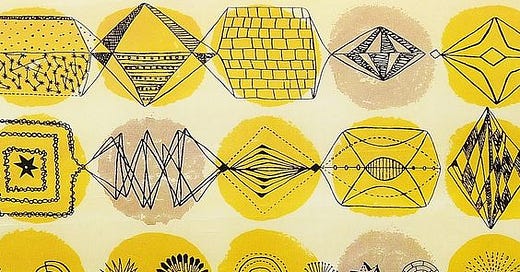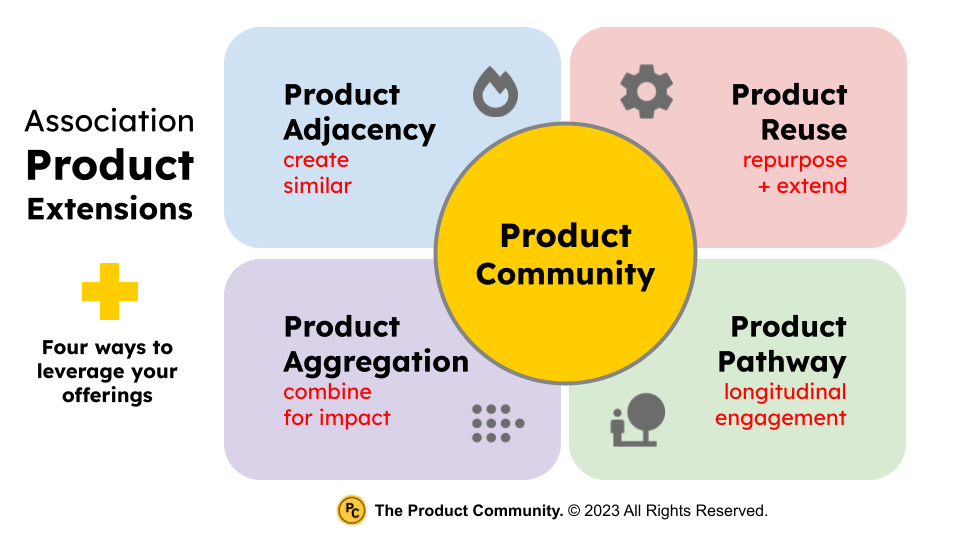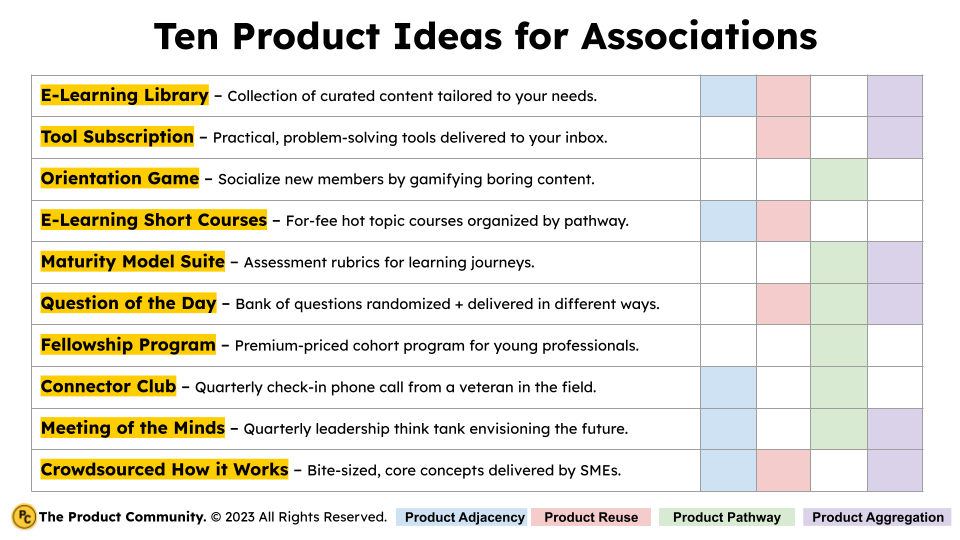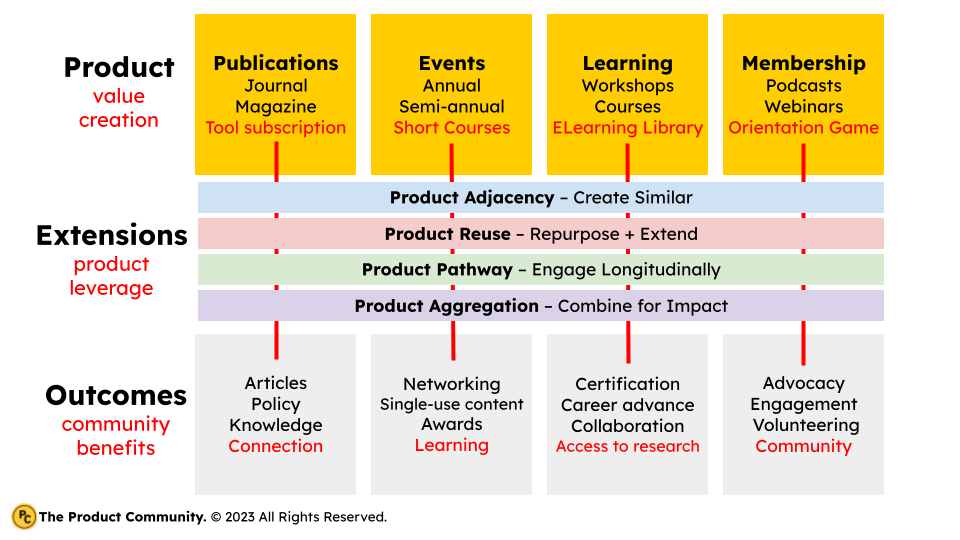Summary
Associations create value for member consumption, engagement, and connection. If we do this often and well enough, we will derive the following outcomes:
Diversified revenue
Thriving membership
Move-the-needle impact
In the product community, we believe in leverage and reuse. What works? What do people love? What engages people? How might we extend or enhance this value? How might we streamline new product development? How might we simplify the innovation process?
The product community is a product development learning community designed specifically for associations.
What Is A Product?
“The world will not evolve past its current state of crisis by using the same thinking that created the situation.”
Albert Einstein
Associations are in the business of understanding and empathizing with their members so they can deliver value for them. I define ‘product’ intentionally broad: anything of value produced by an association. For more information, see my article What is a Product?
Standard examples include events, publications, podcasts, courses, webinars, or membership. As you can see from the below graphic, they can be grouped in lots of ways. Just choose a simple organizing structure and stay consistent.
What’s more important than products are the outcomes they create for your community. Here is where we can tease out synergies across offerings. From this, comes new possibilities for creating new products.
This is how your community can benefit from your investment in product (see the section Investments, Outcomes, and Returns in the What is a Product? article).
What’s important, however, is that most of what we create is underutilized. That is, these examples – even the cash cows of membership and annual conference – are largely built for tactical execution not strategic evolution. What do I mean by this?
Our offerings are one and done, single use solutions with a limited life.
Our offerings are rigid, ingrained, and staff-intensive. They are hard to change or extend.
In a product community, products are built on an agile, strategic framework. This means taking a standard association product and building it for maximum reach. A product framework helps you identify and leverage underutilized value in order to extend its original intention. It also helps you extend possibilities, reach new markets, and diversify revenue. There are three features:
Longitudinal Framework | Value that happens over time. The product community is built on a durable, longitudinal product framework. Value comes not only from immediate satisfaction, but over time.
Productized Services | Value that can be extended. All associations build products; they tend not to build or deliver products in ways that they can be extended or packaged so members can easily consume or use them.
Cross-Functional Teams | Value created through high-impact collaboration. In the product community, innovation is cross-functional and comes from different areas of the association. This synergy helps get the best ideas to market while creating new efficiencies and healthy trust.
These three, overarching features allow us to think more expansively about how we create and deliver new products. It is how we position our resources away from non-value creations activities and more deliberately toward building value for members hungry for relevant content and experiences.
Leveraging underutilized content, programs, or offerings is called product extensions.
Product Extensions
“A tree produces thousands of blossoms in order to create another tree. Its abundance is safe, beautiful, and highly effective.”
William McDonough & Michael Braungart
Cradle to Cradle
As part of this newsletter, I wrote an article on leverage. By leverage, I mean extending content, practices, or intelligence for greater impact or return.
When we think of product types in the world of associations, it’s fairly fundamental. We mostly, but not always, do events, publications, membership, and learning.
These “offerings” aren’t necessarily products so let’s see if we can translate through four product extensions.
Product Adjacency. Developing new products that are closely related to existing offerings. It involves expanding or leveraging existing capabilities or resources to create new opportunities that address current or emerging member challenges.
Product Re-use. Similar to an adjacent product, product re-use is stretching the life of our existing offerings beyond single use. An example is bite sized learning, which takes longer content and chunking it into usable learning so it can be consumed in a new way.
Product Aggregation. Combining content or programming in a way that presents additional or new value. This can be a library subscription to aggregated content or bundling disparate content to create something new.
Product Pathway. Experiencing a product or multiple products over time (longitudinal consumption) will create a multiplier effect resulting in increased engagement, improved knowledge retention, and greater impact.
The product community® ties together these product extensions by focusing on the member journey. It is important for us to conduct continuous discovery with our communities! It is this sustained social and cultural relationship-building that results in deeper understanding of our members (as people and professionals).
Over time, we can translate this intelligence so we can get better at developing the value they want out of their association.
Ten Revenue-Bearing Product Ideas
“What if humans designed products and systems that celebrate an abundance of human creativity, culture, and productivity?”
William McDonough & Michael Braungart
Cradle to Cradle
As promised, here is the list of ten product ideas. They may not be the most visionary ideas in the world (that’s not the point), but they are part of an ecosystem, an extension of the value we already create.
As we’ve said many times in this newsletter, the goal is not to create more stuff. The goal is meaningful connection, usable value, and ongoing engagement. People want associations to help solve their problems. So here are ten off-shoots or descendants.
E-Learning Library. Collection of curated content tailored to member needs. Can be delivered in varying lengths bundled by theme. Type of revenue: non-dues.
Tool Subscription. Practical tools (models, frameworks, surveys, etc.) to engage members and to foster problem solving and longitudinal engagement. Can be delivered via email or social media. Include video intros or questions of the day (see #6). Type of revenue: non-dues.
Orientation Game. Help socialize new members by gamifying boring, rote content. Type of revenue: sponsorship.
E-Learning Short Courses. Fee-based courses (non-dues revenue) themed by hot topic, foundational knowledge, or required learning needed for continuing education. Type of revenue: non-dues.
Maturity Model Suite. A competency-based assessment rubric to help your association create longitudinal learning journeys. See this article for an example maturity model. Type of revenue: sponsorship or non-dues.
Question of the Day. A bank of questions randomized + delivered in lots of different ways (text, email, social media, or mobile app like QStream). This is especially useful for associations that have continuing education or licensure requirements. Type of revenue: sponsorship or non-dues.
Fellowship Program. A premium priced cohort program for young professionals. Longitudinal in nature, anchored by authentic engagement, and includes a required outcome or thought piece that can be shared with the broader community. Type of revenue: sponsorship and non-dues.
Connector Club. A quarterly check-in phone call from a veteran in the field to a new professional. Could be linked to programmatic inputs and outputs or simply a nice way to deliver a lo-fi, high-touch connective community. Type of revenue: sponsorship.
Meeting of the Minds. A quarterly interdisciplinary think tank in which leaders from the field come together to envision the future. Outcomes could include an annual report, insight to the board, or way to create a powerful, longitudinal community. Type of revenue: sponsorship.
Crowdsourced How it Works. Key concepts presented by experts in the field which can be recorded (audio and video), bite-sized, and delivered in lots of interesting ways. Type of revenue: non-dues.
This graphic combines the product ideas with the type of extension (product adjacency, product reuse, product pathway, or product aggregation).
Connecting + Solving Problems
“The day before something is a breakthrough, it’s a crazy idea.”
Peter Diamandis
Leverage is a product community® mantra. We believe that people don’t need or want more stuff. We believe that people desire meaningful connection, usable value, and ongoing engagement. People want associations to help solve their problems.
This graphic demonstrates how it might work. How can we leverage the great stuff we put out?
We design it on a product framework and leverage product extensions. From this, we can expect new outcomes to both delight and challenge our membership communities (while bringing them back for more).
In future articles, we will dig deeper into product systems. We will answer these questions (outlined in Melissa Perri’s book Escaping the Build Trap):
How do all our products work as a system to provide value to our customers?
What unique value does each of the product lines offer that makes this a compelling system?
What overall values and guidelines should we consider when deciding on new product solutions?
What should we stop doing or building because it does not serve this vision?
Until then, we wish you continued success on your product journey!
Just remember, product-led growth fuels connection. Join the product community and flip your destiny.
About the Author
James Young is founder and chief learning officer of the product community®. Jim is an engaging trainer and leading thinker in the worlds of associations, learning communities, and product development. Prior to starting the product community®, Jim served as Chief Learning Officer at both the American College of Chest Physicians and the Society of College and University Planning.
Please contact me for a conversation: james@productcommunity.us.








